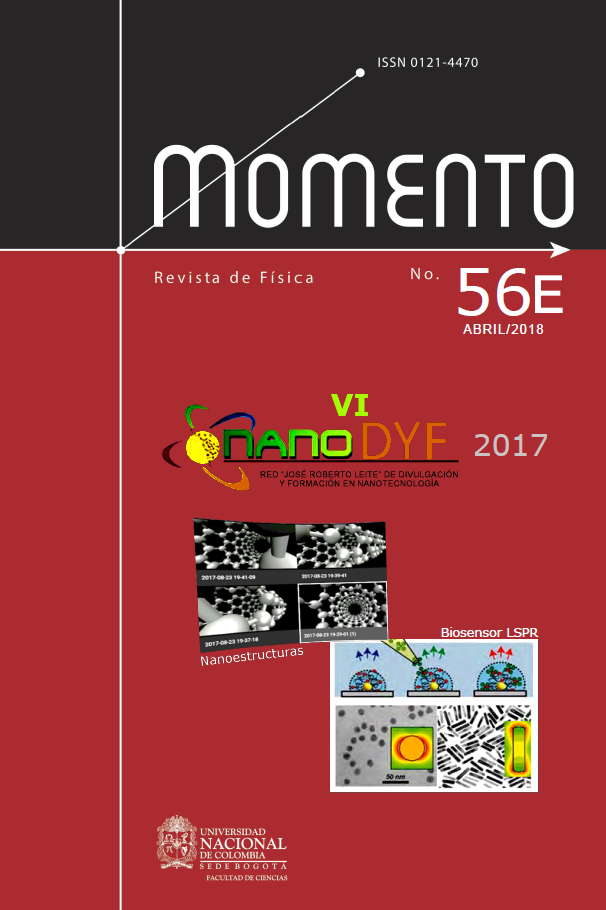¿CÓMO SE PUEDEN USAR LOS NANOPLASMONES EN LA VIDA DIARIA?
HOW CAN NANOPLAMONS BE USED IN DAYLY LIFE?
Keywords:
Biosensores, resonancia de plasmón de superficie, nanoparticulas metálicas. (es)Biosensors, SPR resonance, plasmons, metallic nanoparticles. (en)
Downloads
Food, medicine or the care of the environment are basic elements of daily life on which our well-being depends. Nanotechnology contributes providing security and comfort. The development of biological sensors or biosensors is a tool that is offered to be used in areas as diverse as Biomedicine and clinical diagnosis, gardens, veterinary analysis, analysis and control of fermentation, analysis and production of beverages and food, virus analysis and bacteria, pharmaceutical analysis, industrial waste control, pollution control and monitoring, mining, toxic and industrial gases, and even military applications. Until a few years ago a biosensor was considered to be any analytical probe that introduced into a biological medium would give a quantifiable signal. Recently, nanotechnology has discovered surface plasmon resonance (SPR), a phenomenon that may be the basis of a very powerful biosensor that exhibits unparalleled advantages over other available methods. In this work we show the principles of the operation of a nanoplasmonic biosensor, its characteristics and its comparative superiority in terms of detection speed, high specificity, high sensitivity and possibility of real time analysis from detecting minimal changes in the refractive index of the detection surface and its immediate vicinity. Finally we will take care of an advance that promises even more advantages and is the nanoparticles used as biological sensors of clean, safe and accurate application thanks to the extremely high location of the immense electric fields nearby (LSPR).
References
M.S. Tame, K.R. McEnery, S.K. Ozdemir, J. Lee, S.A. Maier, and M.S. Kim. Nature Physics, Vol.9, June (2013).
A. Camacho y M. Zapata. RDU, revista digital universitaria, revista.unam.mx, Vol.16, No.5 (2015).
A. G. Brolo. Nature Photonics 6, 709 (2012).
Lai, E.P.C., IMohammed I., Mullet W.M., and YeungJ.M., Analytica Chimica Acta, 444, 97-102, 2001.
Borja Sepúlveda, Paula C. Angeloné, Laura M.Lechuga, Luis M Liz- Marchan, Nanotoday 4, No.3,244 (2009).
A. D. McFarland and Van Duyne. Nano Lett. 3, 1057–1062 (2003).
P.J. Rodríguez-Cantó, M. Martínez-Marco, F. J. Rodríguez-Fortuño, B. Tomás-Navarro, R. Ortuño, S. Peransí-Llopis, and A. Martínez, Opt. Express 19, 7664-7672 (2011).
How to Cite
APA
ACM
ACS
ABNT
Chicago
Harvard
IEEE
MLA
Turabian
Vancouver
Download Citation
Article abstract page views
Downloads
License
Copyright (c) 2018 MOMENTO

This work is licensed under a Creative Commons Attribution-NoDerivatives 4.0 International License.
Those authors who have publications with this journal, accept the following terms:
a. The authors will retain their copyright and will guarantee the publication of the first publication of their work, which will be subject to the Attribution-SinDerivar 4.0 International Creative Commons Attribution License that permits redistribution, commercial or non-commercial, As long as the Work circulates intact and unchanged, where it indicates its author and its first publication in this magazine.
b. Authors are encouraged to disseminate their work through the Internet (eg in institutional telematic files or on their website) before and during the sending process, which can produce interesting exchanges and increase appointments of the published work.




















